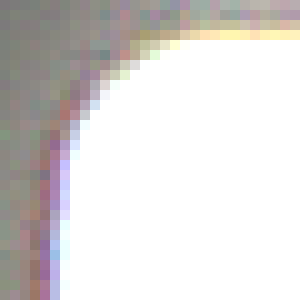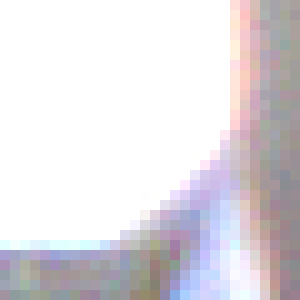|
Upper-left Sprocket Hole Corner |
Lower-right Sprocket Hole Corner |
 |
 |
Early Experiences With Film Capture
There are various film-capable scanners. They can be broken into two main categories. One is a film-capable flatbed scanner which is usually a flatbed scanner with a film adapter. It should be noted that NONE of these is really meant for “movie” film and are geared toward photographer's (amateur or otherwise) negatives and slides.
The problem with using a normal flatbed document scanner is that these scanners are 'reflective;' that is, the light source is reflected off of the document being scanned and this reflected light is captured by the sensor. In order to scan film, however, the light needs to be projected through the media rather than bounced off of it. There are several ways to do this with a flatbed scanner and they all entail a modification or adapter for the typical flatbed scanner. On the web you can find means of making your own adapting device for a standard reflective scanner like the one at http://home.sci.fi/~animato/scanning/scanning2.html though you can now find many cheaper home flatbed scanners that come with 'film-adapters.'
The plan was to build a film-advancer using parts from a series of super8 and 8mm junk projectors and a stepper-motor controlled from a parallel port. I didn't have grandiose plans for the device, I just needed to be able to pull the film across a fixed track in the scanner, I didn't even plan on using a takeup reel and would just let the film trail into a container. The device would be controlled from a parallel port on the computer and the scanner would be run from software written against the TWAIN interface (there's a large number of resources on the web that talk about how to control a stepper motor from a parallel port like http://neil.fraser.name/hardware/stepper/cpu.html and the cheap way using a stepper motor from an old disk drive described at http://www.doc.ic.ac.uk/~ih/doc/stepper/). The computer would: scan a strip of the film, forward the film a fixed amount, and then scan again. The process would run until the entire film was scanned.
Given the 500 lines per frame requirement, and the specifications (also here) of the film, 3000 dpi is a minimum. It so turns out that flatbed scanners with film adapters have recently hit the home (read: cheap) market. The one I chose was the Epson 3170 (which allegedly has the very same optics as the more expensive 3200). Interestingly the very same specs seem to have come out on several models from various companies at about the same time. I suspect that is because they are all using the same third party optics in them. I got the scanner from “Staples” because I was not sure I would be able to do what I wanted to with it and I wanted to be able to bring it back if I couldn't.
As a proof of concept I managed to get the scanner set up so that I could scan a strip of the film, then forward the film with the lid closed simply by pulling it through, and then scan again without ever opening up the scanner lid or resetting it. I took this limited success as verification that, if I had a stepper motor pulling the film through and software that controlled the motor and executed successive scans, then I could do what I wanted to on the capture side of the problem.
Unfortunately, I did not anticipate the poor quality of these 'cheap' scanners. I suspect that most people that buy these scanners never really use the advertised extremes because they are no where near what they claim. While they do get literally 3200 dots-per-inch, these dots typically 1) overlap one another, 2) have misaligned channels (the red is shifted from the blue which is shifted from the green) and 3) The dynamic range is terrible. In the picture below you can see the hard edge of the sprocket hole. Notice the discoloration along the edge on one side and the complementary color discoloration on the opposite side of the sprocket hole. This is a clear indication that at least one of the channels is shifted from the others.
|
Upper-left Sprocket Hole Corner |
Lower-right Sprocket Hole Corner |
 |
 |
As a result of this experiment I had obtained a series of (very poor quality) scans of about 50 strips of film after which I brought the scanner back due to the fact that I was not satisfied with the quality.